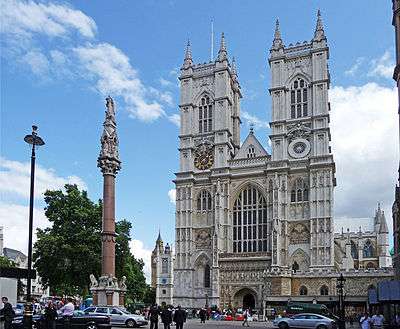Gatehouse Prison

Gatehouse Prison was a prison in Westminster, built in 1370 as the gatehouse of Westminster Abbey and first used as a prison by the Abbot, a powerful churchman who held considerable power over the precincts and sanctuary. It was one of the prisons which supplied the Old Bailey with information on former prisoners (such as their identity or prior criminal records) for making indictments against criminals[1]
While he was imprisoned in the Gatehouse for petitioning to have the Clergy Act 1640 annulled, Richard Lovelace wrote "To Althea, from Prison", with its famous line
"Stone walls do not a prison make, Nor iron bars a cage"
The Gatehouse prison was torn down in 1776. At its site, in front of the Abbey's Great West Door, is the Westminster scholars' Crimean War Memorial.
Notable inmates
Giles Wigginton, Puritan cleric and controversialist, was imprisoned for 2 months around 1584, for refusing to take an oath. Sir Walter Raleigh was held here the night before he was beheaded in Old Palace Yard, Westminster on 29 October 1618.[2] Throughout the 17th century, the Gatehouse prison held many famous dissenters and those charged with treasonous crimes, including Laurence Voux,[3] Christopher Holywood,[4] Richard Lovelace, Samuel Pepys, Thomas Bates and Henry Savile. Sir Thomas Ragland, MP.[5] in 1582.
Further reading
- Forsythe, James Neild. State of the Prisons in England, Scotland, and Wales, Not for the Debtor Only, But for Felons Also, and Other Less Criminal Offenders. London: Routledge, 2000. ISBN 0-415-23127-2
- Tanner, Lawrence Edward. Westminster School, Its Buildings and Their Associations. P. Allan, 1923.
References
Coordinates: 51°29′57″N 0°07′44″W / 51.4992°N 0.1290°W